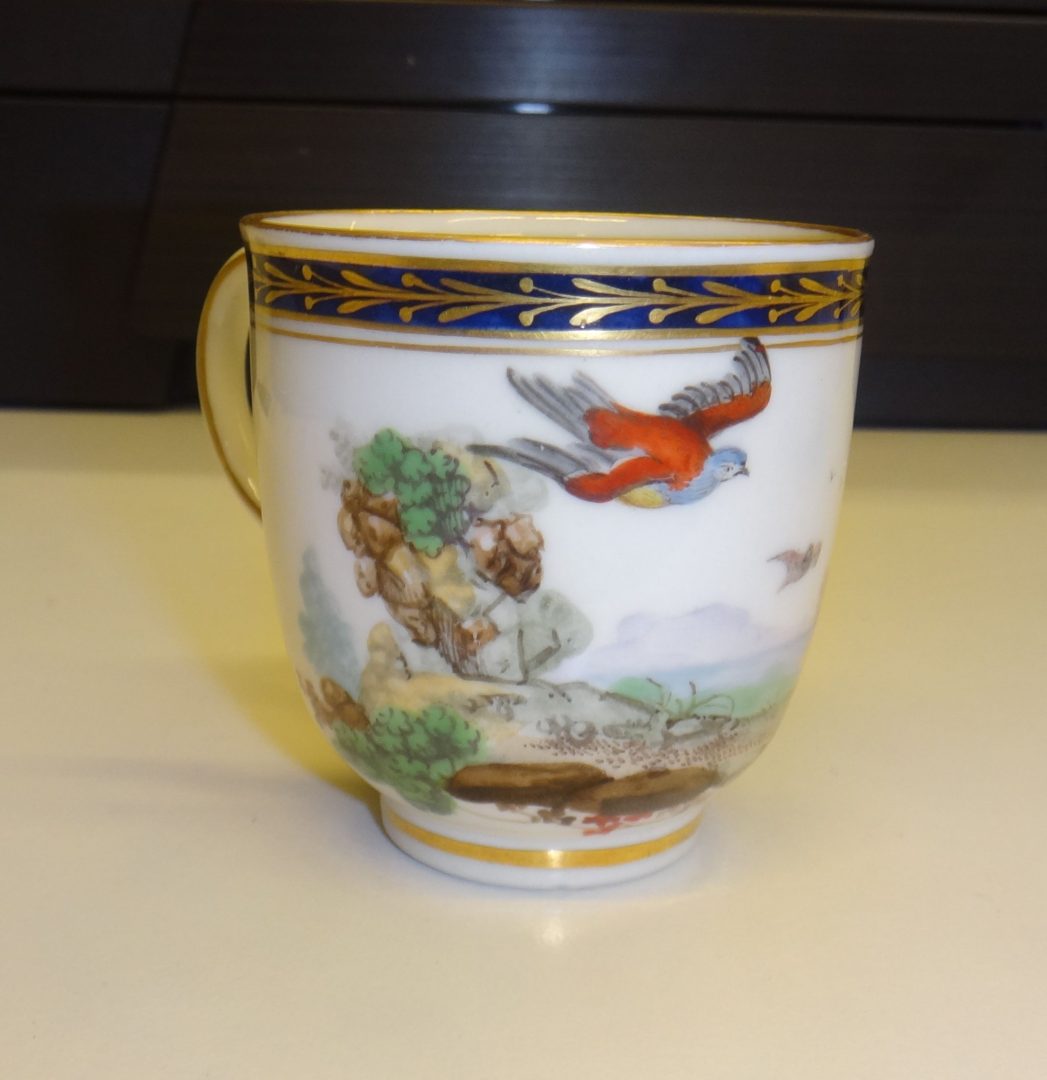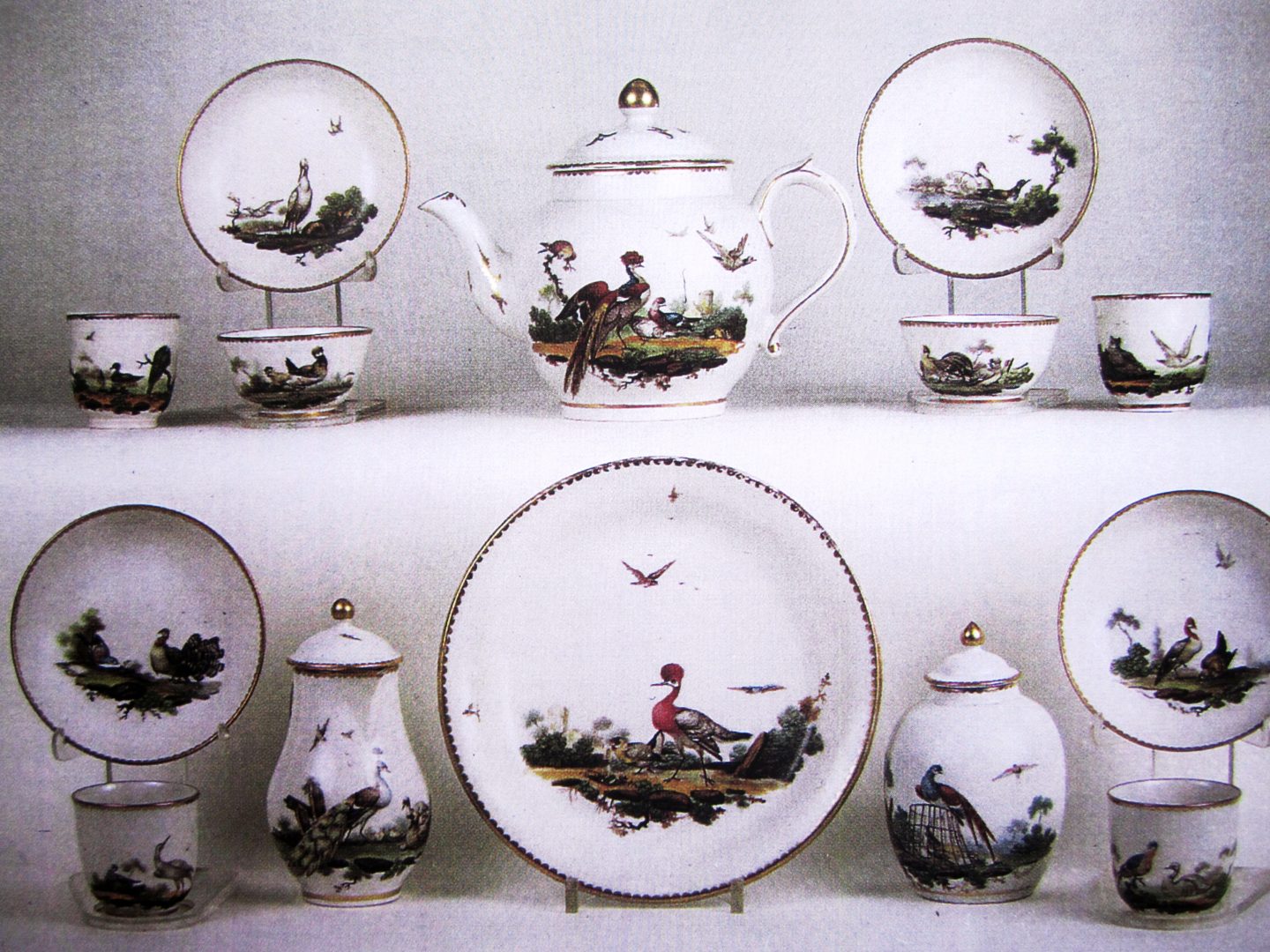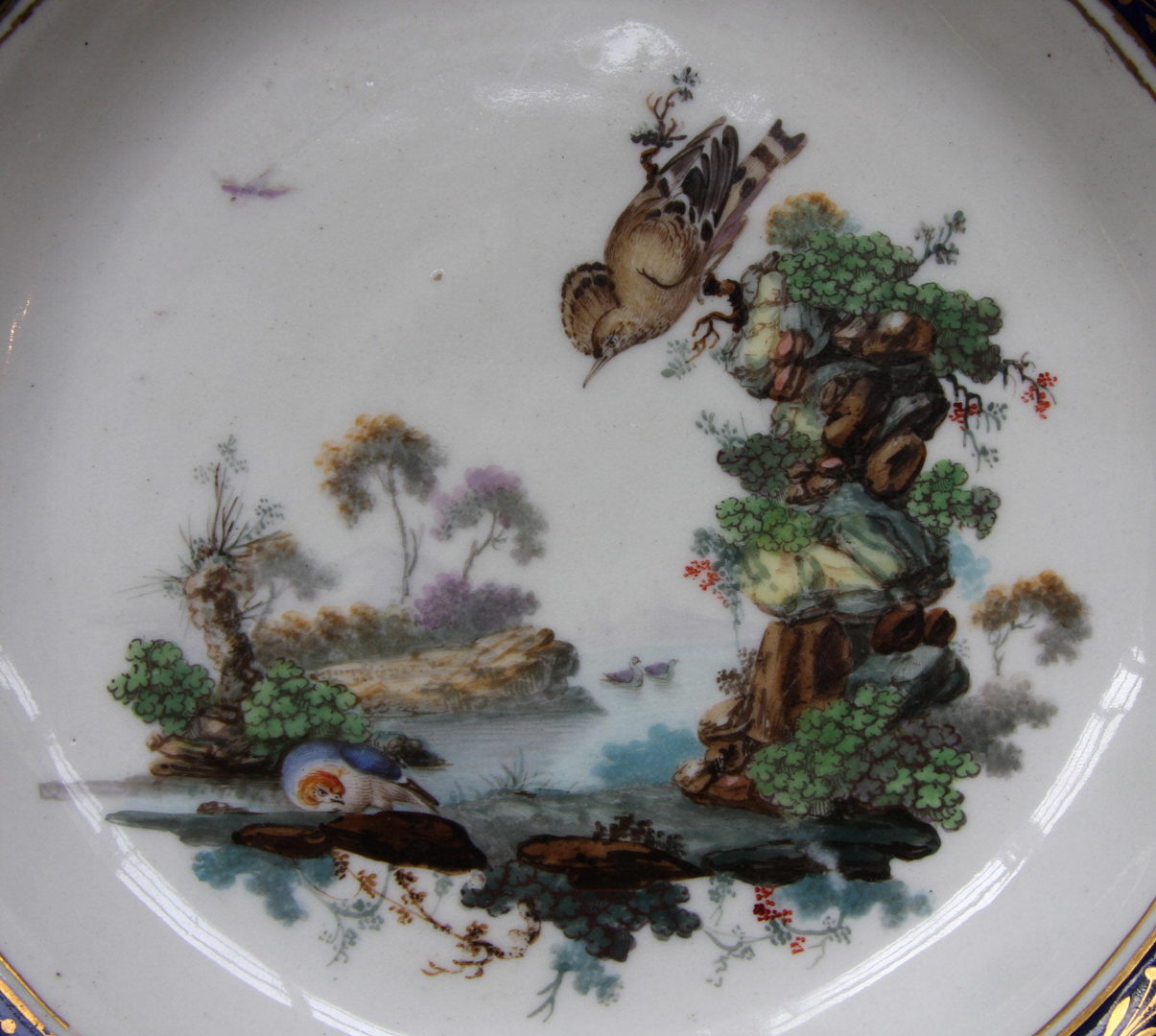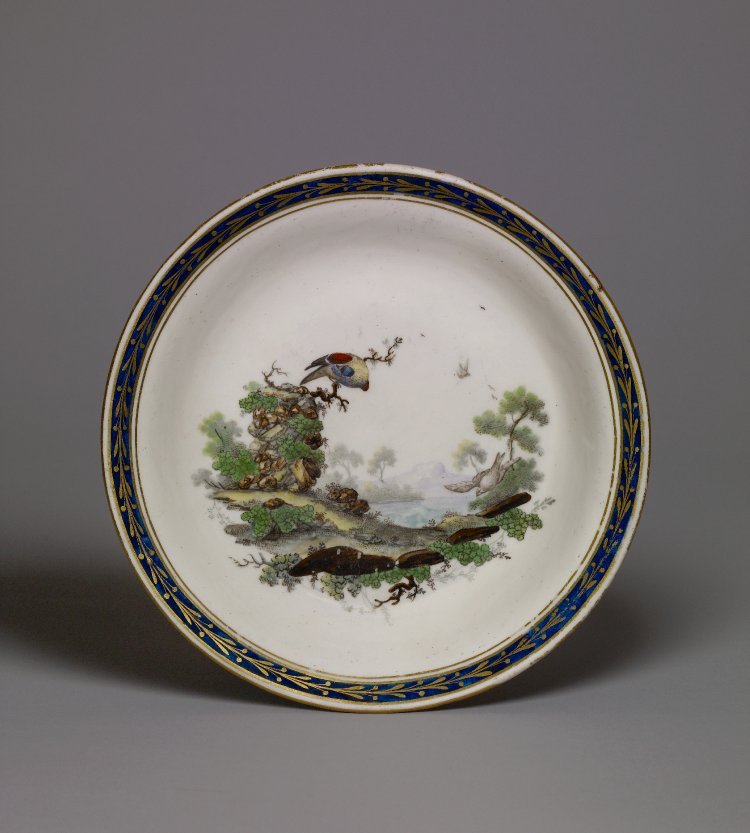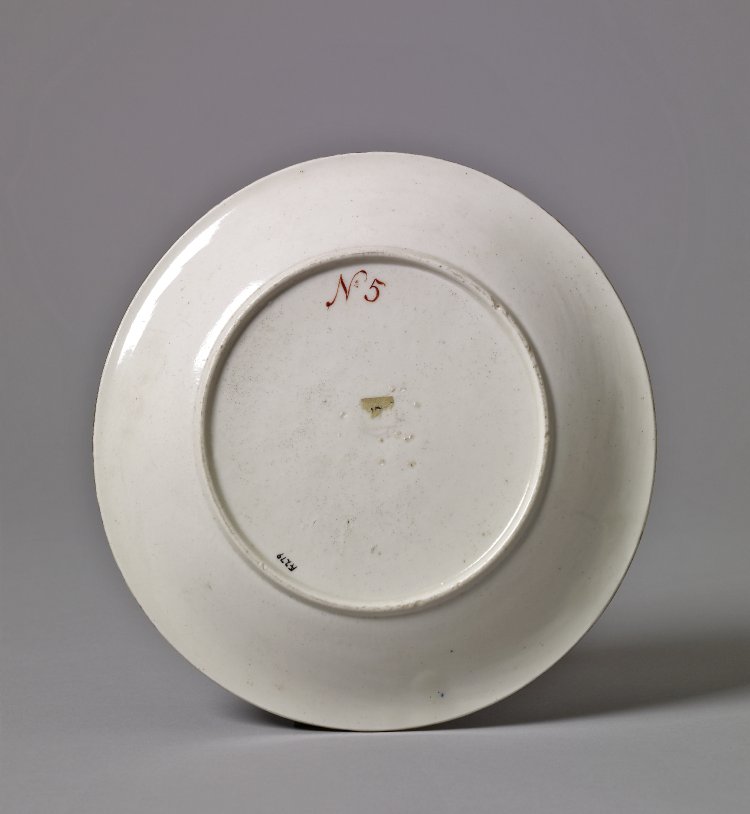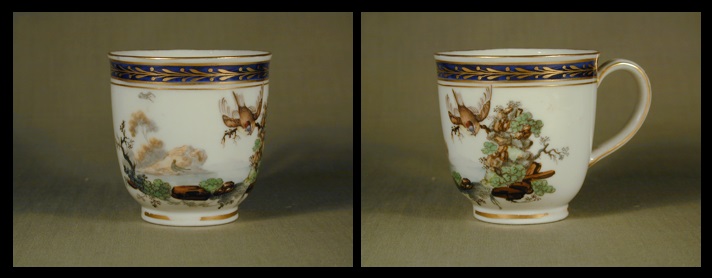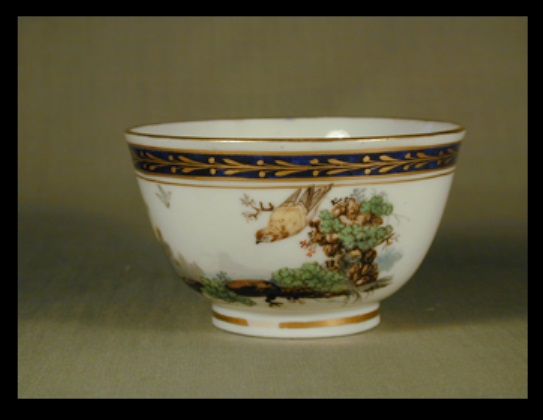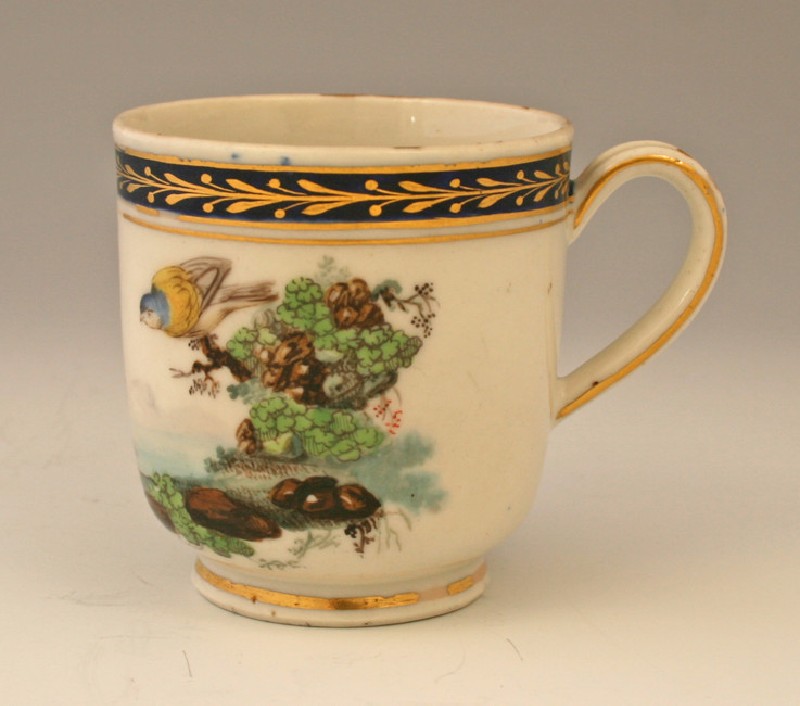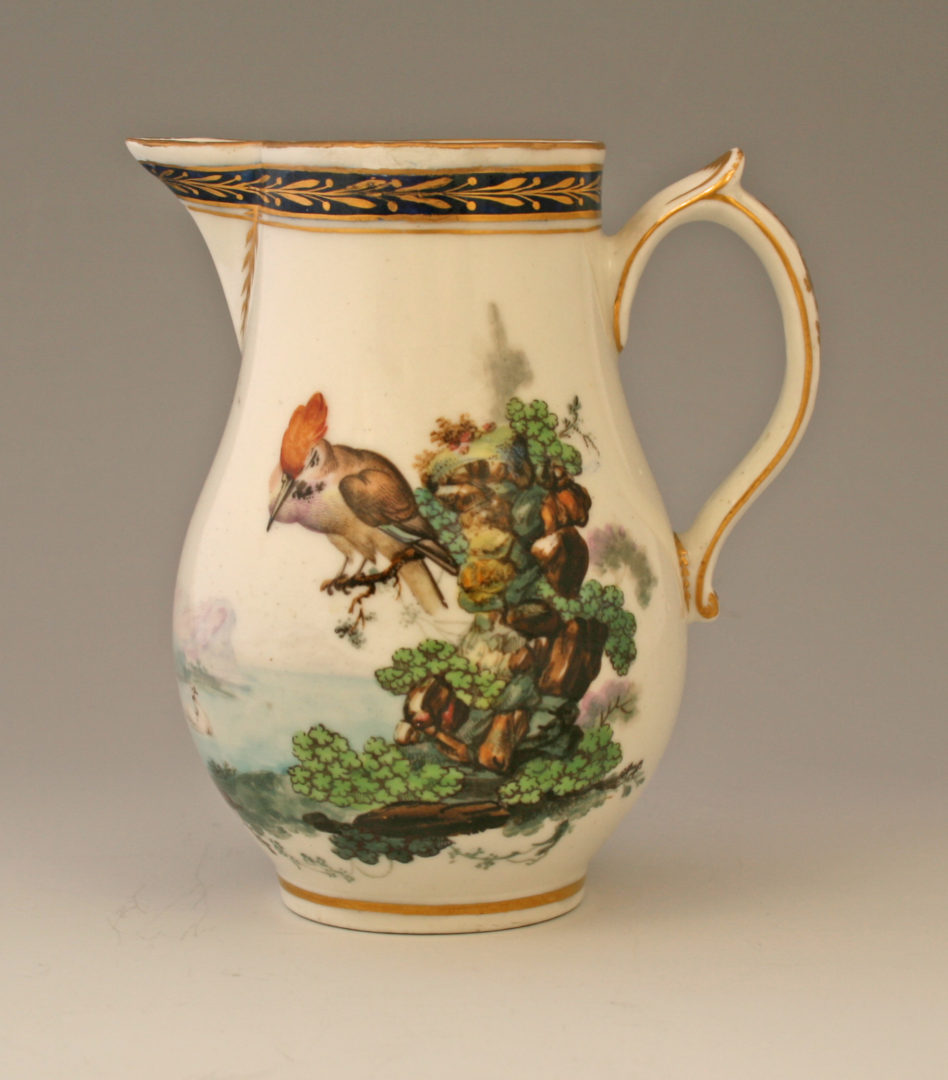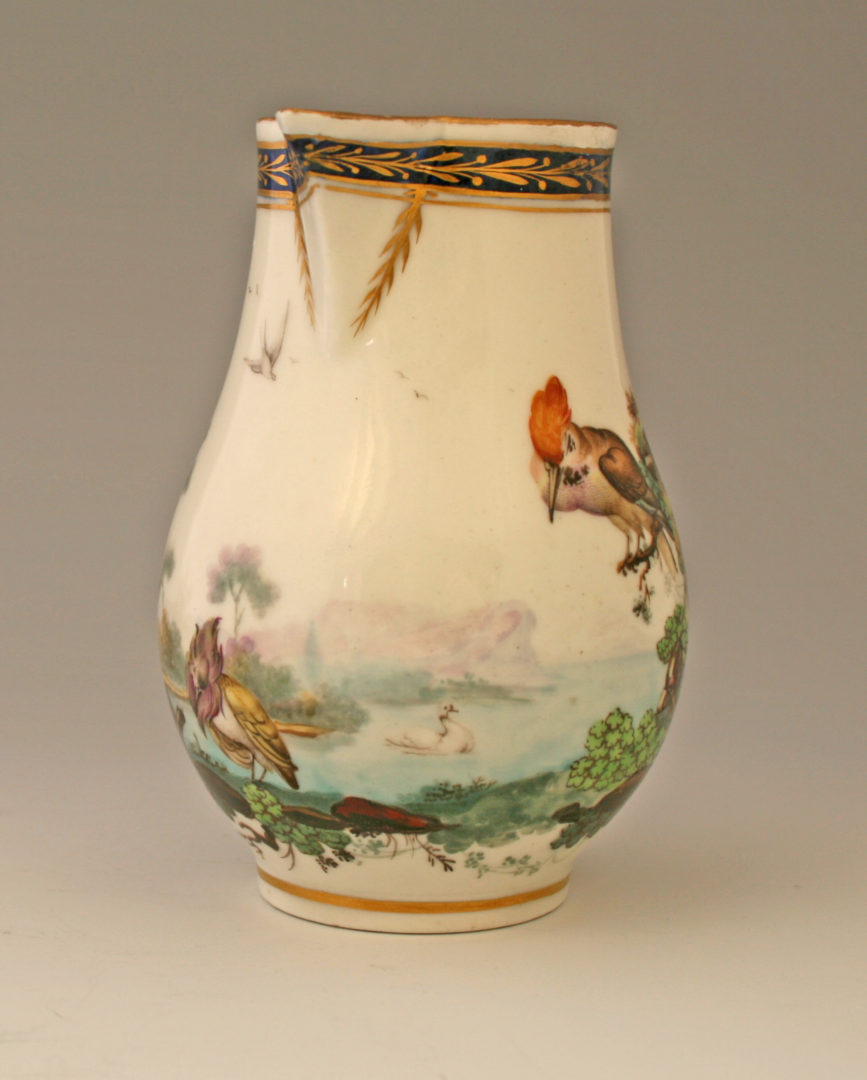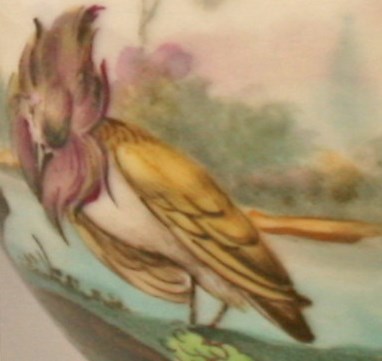1a A New Hall porcelain saucer plate, c. 1785-90, decorated by Fidelle Duvivier with birds in a water landscape (with a hoopoe perched on high rockwork), marked on the reverse with “No. 5” in red. Diameter 21.5 cm. (See also 1b, 4a, b). Photo: Bonhams
2 A New Hall porcelain coffee cup, c. 1785-90, with a grooved handle, belonging to a service with bird decoration by Duvivier (other known pieces shown here). H 6.1 cm. Cf. 5a,b, 7. Photo: Bonhams
Ever since beginning to investigate Duvivier’s decorative work on Sceaux faience and porcelain, I have marveled at what an accomplished bird painter he was – both during his time in France, and again, about twenty years later in England.
It would not have been possible to identify his earlier French work without having the helpful stock of “reference images” provided by one particular New Hall part-service with bird decoration (3), which fortunately still exists intact in a private collection. A careful study of these images revealed a number of stylistic details (e.g. in the bird poses and rendering of vegetation) that originated in his French work and carried over into his later bird painting. But here we’ll turn our attention to a second, lesser known, New Hall bird service that Duvivier decorated, with surviving pieces preserved in a few private and museum collections.
3 Pieces of a New Hall porcelain tea and coffee service decorated with birds by Fidelle Duvivier,
c. 1785-90. Private collection. Photo: Christie’s
The part-tea and coffee service mentioned (3) was auctioned by Christie’s, London on October 10, 1988, lot 237(i), and acquired by an English collector who described these pieces in an article published in 2008 in the English Ceramic Circle Transactions.(ii) Most of the birds are depicted in farmyard surroundings along with domestic poultry. Although Duvivier’s earlier birds on Sceaux faience and porcelain often stand on an elevated rocky plateau, anatomically they share many physical traits with the later New Hall specimens.(iii)
What is different about the second New Hall bird service? As one can see from the examples shown here, the rims of all the pieces have an underglaze cobalt blue band with an added gilded pattern. They bear a mark “No 5” in red enamel on the reverse or base (as seen in 5b), but the meaning of this number is not known.(iv) There are no known saucers for the cups.
1b Detail of saucer plate shown in 1a.
This service appears to show all of the birds near a river or some body of water. Most of them are perched on a branch projecting from some tall rockwork. Note in the plate detail above (1b) how Duvivier renders the vegetation by merely outlining in brown the scalloped green leaves. This technique is frequently seen on his New Hall work.
Geoffrey Godden illustrated this piece, which he calls a “bread and butter plate,” in his book New Hall Porcelains(v), and when it was later sold at Bonhams, London, on April 23, 2008 (lot 283) the lot description mentioned that the “saucer dish” had belonged to both the David Holgate and Godden Reference Collections. David Holgate, a New Hall author and expert, first illustrated it in an article published in the English Ceramic Circle Transactions(vi), identifying the bird as a hoopoe. The British Museum has a saucer dish of the same size in their collection (4a) but it is difficult to recognize any particular species here.
4a New Hall porcelain saucer plate, marked with ‘No 5’ in red on the reverse. Diameter 7.75 inches. ©The Trustees of the British Museum, London (Franks.279)
4b Reverse side of plate 4a with mark (‘No 5’), which also appears on the reverse of pieces shown in 1, 2 and 8. ©The Trustees of the British Museum, London (Franks.279)
The two cups shown in 5a, b and 6 are in the same private collection as the larger bird service, and have been previously published, as mentioned in note(ii).
5a, b Two views of a New Hall hard paste porcelain cup painted by Duvivier. Private Collection.
Photos: Pat Preller
6 New Hall hard paste porcelain teabowl. Private Collection. Photo: Pat Preller
7 New Hall hard paste porcelain coffee cup, H 6.2 cm. Presented by Peter Glazebrook, 2009 (WA2009.48). Image ©Ashmolean Museum, University of Oxford
The only other examples of this service I know of are a coffee cup (7) and a milk jug (8a, b) in the reserve collection of the Ashmolean Museum, Oxford.(vii) One could be tempted to think that the large bird with the red tuft on the jug was some kind of woodpecker, although the rest of the coloration does not correspond to those woodpeckers native to the British Isles.
But the front of the jug (8b) shows a bird species we’ve encountered before on Duvivier’s work – on one teacup of the larger New Hall bird service, and on a Tournai plate decorated for the Lyncker family of The Hague: a male ruff. (See blogpost #6, April 12, 2017) (viii).
8a, b New Hall hard paste porcelain jug, H 11.8 cm. Presented by Peter Glazebrook, 2009 (WA2009.47). Images ©Ashmolean Museum, University of Oxford
8b (A male ruff appears at lower left).
8c Male ruff (Detail of 8b)
Although Duvivier clearly demonstrated his acquired talents in the painting of these two bird services, there was perhaps not enough market demand for this more expensive decoration by the late 1780s. He painted a greater number of coffee and tea services with figures in simpler landscape settings (often including the familiar smoking kilns of his surroundings). It has been pointed out that a few of his finer polychrome New Hall services and (signed) figure subject mugs were likely freelance work – and some were apparently commissioned by the New Hall partners since they were passed down in their families.(ix) By 1790 Duvivier’s “engagement in the New Hall porcelain manufactory [had] expired, and the proprietors [did] not intend to do much in the fine line of painting …,” as he wrote in a letter to the Derby manufactory, hoping for a new offer of part-time employment, which, sadly, did not materialize for him.(x)
NOTES
(i) Most pieces had a collector’s label attached, and I recently discovered that the service had once belonged to an English-Swiss couple, Sidney & Jenny Brown, who were avid art collectors and lived in Winterthur, Switzerland. I’ve posted further details about them in blogpost #12 (January 16, 2018).
(ii) See Jonathan Horsfall Turner, “Some Rare Duvivier Pots,” English Ceramic Circle Transactions, Vol. 20, Part 1 (2008), pp. 139-160 (5a, b; 6 of the second bird service are also shown). See also my blogpost #6 (March 23, 2017) relating how a few examples of this service helped identify Duvivier’s birds on two Hague-Tournai plates; and nos. 56a,b; 58 (full view of the milk jug with a peacock), as well as 59, 60 on pp. 52-54 of In the Footsteps of Fidelle Duvivier (2016).
(iii) See my blogpost #9 (August 27, 2017) for examples, and pp. 20, 21, 23, 53-54 of Footsteps.
(iv) On all pieces of the other bird service (3) one finds a similar mark: “No 11” in red enamel.
(v) Geoffrey A. Godden, New Hall Porcelains (2004), p. 176, pl. 75. He describes it as being painted on the underside with ‘No 7’, but this appears to be an error. It has ‘No 5’ in red enamel on the base.
(vi) David Holgate, “Fidelle Duvivier Paints New Hall,” ECC Transactions, vol.11, pt.1 (1981), p. 13 and pl. 9c.
(vii) Peter Glazebrook gave both of these pieces together with six other New Hall teabowls and coffee cups decorated by Fidelle Duvivier to the Ashmolean museum in 2009.
(viii) https://chjacob-hanson.com/two-hague-decorated-tournai-plates-with-duvivier-bird-decoration/
(ix) Godden, op. cit. (2004), discusses a dessert service made for the New Hall factory manager, John Daniel with numerous illustrations, pp. 164-72. Another Duvivier-New Hall service with children’s games and pastimes was featured in blogpost #17, July/August 2018 and once belonged to another New Hall partner, Charles Bagnall.
(x) Godden, op. cit. (2004), p. 161.


